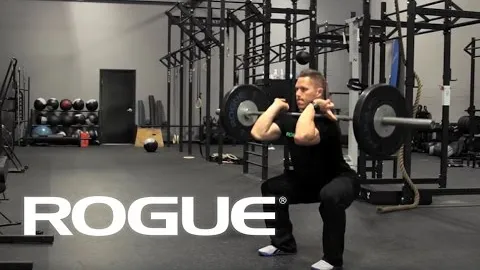The Front Squat Exercise: Building Strength and Stability for Lower Body
Front squats are a compound exercise that primarily target the muscles of the lower body, including the quadriceps, hamstrings, and glutes. This challenging movement also engages the core, upper back, and shoulders, making it an excellent exercise for overall strength development. In this article, we will dive deep into the front squat exercise, discussing its benefits, proper form, variations, and incorporating it into your workout routine.
Benefits of Front Squats
Front squats offer several benefits that make them a valuable addition to any strength training routine. Some of the key advantages include:
- Greater Quadriceps Activation: Front squats place a greater emphasis on the quadriceps muscles compared to back squats. The front-loaded position forces the quad muscles to work harder, leading to greater growth and strength gains.
- Core and Upper Body Engagement: The front squat position requires significant core stabilization to maintain an upright posture. Additionally, the upper back and shoulder muscles are engaged to hold the bar in position. Over time, this improves overall core strength and upper body stability.
- Improved Mobility and Flexibility: Front squats require a more upright torso position, placing less stress on the lower back. This encourages greater hip and ankle mobility, ultimately improving overall squat depth and range of motion.
- Functional Fitness: Front squats mimic movements performed in daily life, such as picking up objects from the ground or carrying heavy loads. By strengthening the muscles used in these activities, front squats contribute to improved functional fitness.
Proper Form for Front Squats
To perform front squats safely and effectively, follow these step-by-step instructions:
- Set up the Bar: Start by placing a barbell on a squat rack at shoulder height. Position yourself facing the bar with your feet slightly wider than shoulder-width apart.
- Grip the Bar: Reach up and grip the bar with a clean grip, with your fingertips resting on top of the bar and your elbows pointing forward. Create tension in your upper back by squeezing your shoulder blades together.
- Unrack the Bar: Lift the bar off the rack by straightening your legs and stepping backward, ensuring that you have a stable footing.
- Positioning: Position the bar against the front of your shoulders, just below your collarbone. Keep your elbows high, ensuring your upper arms are parallel to the floor.
- Execution: Begin the movement by breaking at your hips and knees simultaneously, descending slowly into a squat. Keep your chest up, back straight, and knees tracking over your toes.
- Full Depth: Aim to squat until your hip crease is slightly below parallel with your knees. Maintaining the correct depth will ensure optimal muscle activation and development.
- Drive Up: Extend your hips and knees simultaneously to drive back up to the starting position. Keep your weight on your heels and maintain proper form throughout the exercise.
Variations of Front Squats
While the traditional front squat is an excellent exercise, there are variations that can be incorporated to target specific muscle groups or add variety to your workouts. Some popular variations include:
- Goblet Squats: Hold a dumbbell or kettlebell at chest level while performing squats. Goblet squats are an excellent option for beginners or those with limited mobility.
- Zercher Squats: In Zercher squats, the barbell is held in the crook of the elbows. This variation emphasizes the core, upper back, and biceps while working the lower body muscles.
- Crossed-Arm Squats: Cross your arms in front of your body, resting the barbell on your deltoids. This modification provides a unique challenge to the upper body while maintaining focus on the lower body muscles.
- Safety Squat Bar Squats: Use a specialized safety squat bar that rests on your shoulders with handles in front. This variation targets the quadriceps, glutes, and upper back muscles.
Incorporating Front Squats into Your Workout Routine
To reap the maximum benefits of front squats, incorporate them into your leg training or full-body workout routine. Here are some guidelines to consider:
- Warm-Up: Prior to starting your front squats, engage in a dynamic warm-up routine that includes exercises like lunges, leg swings, and hip mobility drills. This will prepare your muscles and joints for the squatting movement.
- Progressive Overload: Start with a weight that feels challenging but allows you to maintain proper form. Gradually increase the load over time to progressively challenge your muscles.
- Sets and Repetitions: Perform 3-4 sets of 8-12 repetitions, depending on your specific goals. Adjust the weight accordingly to ensure that the last few reps of each set are challenging but doable.
- Rest Periods: Allow 1-2 minutes of rest between sets to allow for recovery and optimal performance.
- Supplemental Exercises: Complement your front squats with other lower body exercises such as deadlifts, lunges, and hamstring curls to create a well-rounded leg training routine.
- Progressive Variations: As you become more proficient with front squats, consider incorporating variations such as goblet squats or Zercher squats to keep your routine challenging and engaging.
In conclusion, the front squat is a versatile exercise that targets multiple muscle groups while improving strength and stability. Whether you are an athlete, fitness enthusiast, or simply looking to improve your overall fitness level, the front squat should be a staple in your workout routine. Remember to prioritize proper form, progressive overload, and variation to continue challenging your muscles and achieving your fitness goals.
